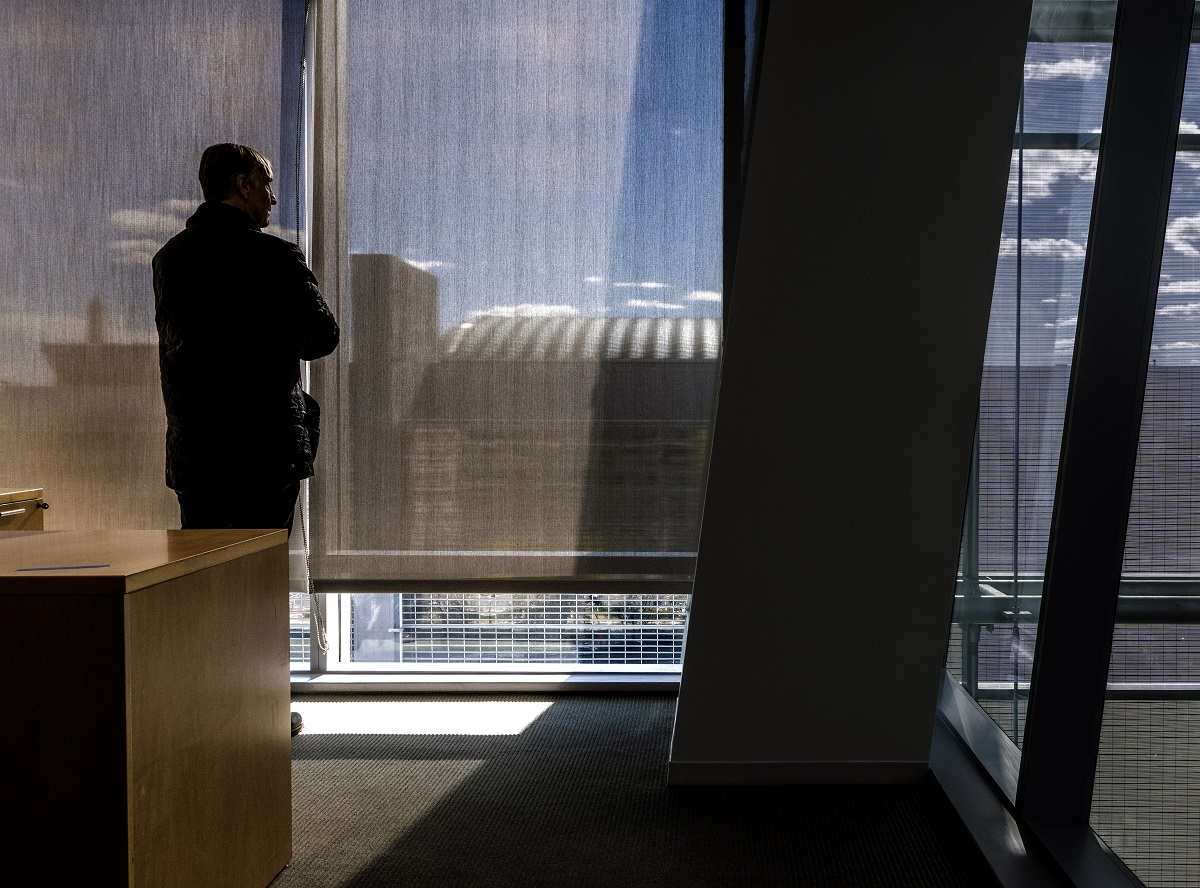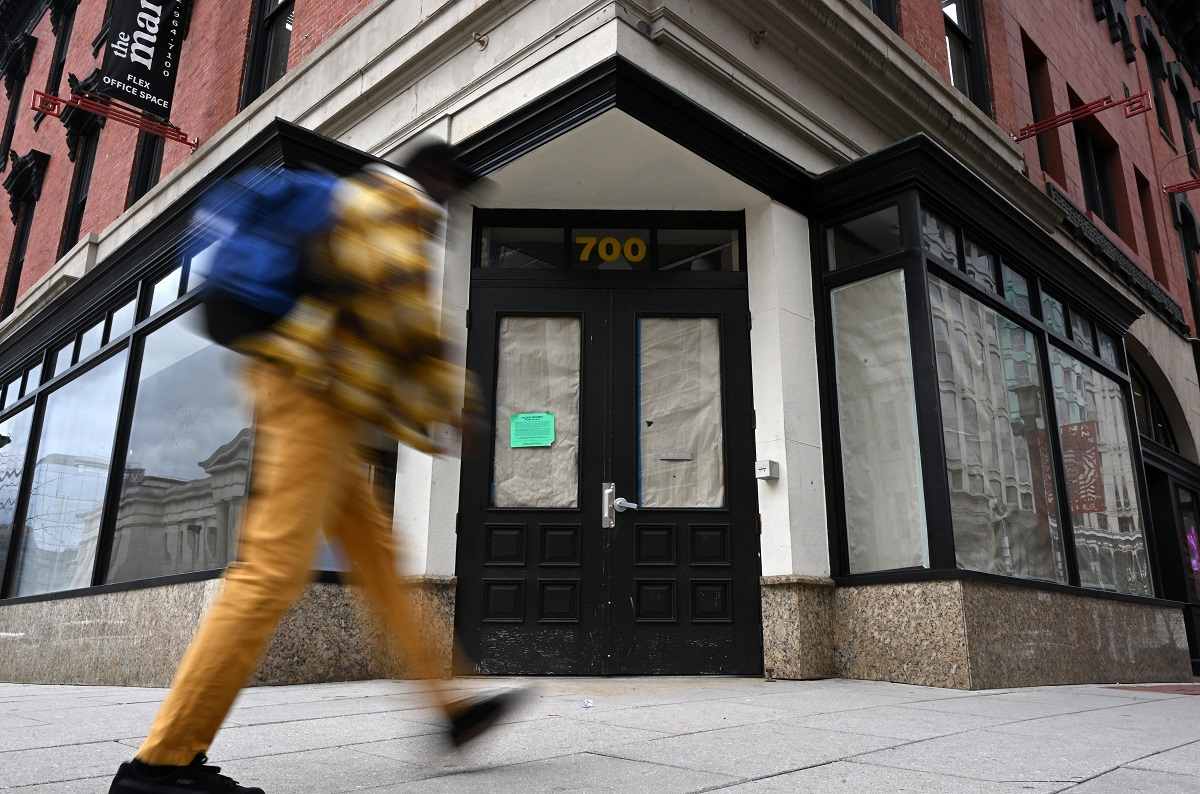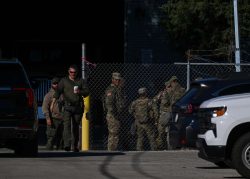
Anthony Lanier looks out the window of his office tower on Pennsylvania Avenue NW in D.C. as his only tenant prepares to relocate. He fears it could take years to find a replacement.
11:52 JST, January 29, 2023
WASHINGTON – As his only tenant was moving out the other day, Anthony Lanier walked through his glass office tower in downtown Washington, all too aware of the looming financial danger he faces.
Mortgage payments of about $1 million a month. A $3 million annual property tax bill.
And, beginning in March, no rental income.
In September, Lanier installed on the outside of his building near the White House a promotional splash worthy of Times Square: a 13-story-high, bright greenish-yellow sign offering discounted rent, “move in ready” offices, and the almost unheard-of option of “month-to-month” leases.
“See it to believe it!” declares a second, equally impossible-to-miss billboard overlooking Pennsylvania Avenue NW.
Lanier, whose hunt for a new tenant began before 2020, is still searching for a deal. He fears it could be two years before he replaces WilmerHale, the law firm that has occupied his building since it opened in 2006 and is moving to a new tower across the street.
“It’s humbling,” Lanier said as he walked the empty corridors of what he touts as “the best 300,000 square feet in Washington,” with a 150-foot-high atrium, lobby waterfall and rooftop views of the Washington Monument. “There are a lot of desperate real estate owners out there.”
As the third anniversary of the pandemic approaches, downtown Washington is a wounded rendition of its once robust self. Even as more of the workforce shows up daily, many streets at the city’s core are pocked by vacant storefronts, moribund sidewalks and offices that, even on the busiest days, are just over half occupied.
Mayor Muriel E. Bowser (D) has made the reinvention of downtown an urgent centerpiece of her agenda as she begins her third term. She promises to encourage the conversion of enough downtown offices to apartments over the next five years to help accommodate 15,000 new residents, an aspiration that has prompted a mix of interest and skepticism among developers.
Yet a newly constituted downtown could take years to materialize. In the meantime, D.C. leaders and business executives worry that declining tax assessments of large office buildings – already down more than 10 percent because of vacancies and an anemic sales market, according to city records – could significantly erode the revenue needed to fund public services. “We have to protect our current commercial property tax base – just period, end of story,” the mayor told The Washington Post’s editorial board recently.
During the economic downturn that followed the Sept. 11, 2001, attacks and the 2008 recession, D.C. officials could depend on the presence of tens of thousands of federal workers to keep money coursing through downtown. But now, with most federal employees still working at home – despite the pandemic’s easing and Bowser’s pleas that the Biden administration require in-person work – downtown can still feel like a deflated balloon.
A couple of blocks from the White House, an encampment of 70 tents splayed across McPherson Square is occupied by dozens of people who don’t have homes. At Metro Center, a security guard sits behind the locked entrance to a handsome 12-story office building that remains empty eight months after its only tenant, the law firm of Williams & Connolly, decamped to new headquarters at the Wharf.
On Seventh Street between Indiana and Massachusetts avenues NW, a strip that includes the Capital One Arena, there are nearly 20 vacant storefronts, including those once leased by Urban Outfitters and Bed Bath & Beyond. At Gallery Place, a popular multiplex cinema – part of a chain of 39 theaters that are shuttering nationwide – is closing in February.
“We’ve been lonely,” said Howard Marks, 78, standing outside his Gallery Place condominium, where he has lived with his wife since 2014. “We miss the office workers, and we miss the people on the street. It has been pretty much a ghost town.”
What has proliferated, he said, is a regular crowd of marijuana dealers and users who have taken to congregating outside the Metro station at the corner of Seventh and H streets NW, a few steps from the Chinatown arch, as well as his building, where two-bedroom condos list for over $500,000. “It feels like the criminals have taken over, that young people can do whatever they want,” Marks said as a man walked by smoking a thick joint.
Ten blocks west, Philip “Pete” Evans, an attorney at Holland & Knight, walked through a mostly empty floor of his firm’s downtown headquarters, a glass high-rise on 17th Street NW. Evans, 62, has commuted to his office nine out of every 10 work days through much of the pandemic. But most colleagues, he said, show up less regularly, with attendance peaking at 50 to 60 percent on Wednesdays.
“It’s not as bad as it was – it was a true ghost town,” said Evans, who misses the camaraderie of in-person meetings and collaborations. “I can only do so much by Zoom.”
He said he hopes that Washington law firms emulate those in New York that are making in-person work more of a requirement than a suggestion. But it’s anyone’s guess when and if that will happen, and how it would be enforced.
– – –
An oversupply of offices
As of the third week of January, the percentage of workers showing up at their downtown offices reached a weekly average of 45 percent, with that number rising to 54 percent on Wednesdays, according to data collected by Kastle Systems, which measures traffic through access cards (the weakest days are those adjacent to weekends).
While ahead of cities such as San Jose and Philadelphia, Washington’s attendance rate lags behind New York, Chicago and Dallas, perhaps because a quarter of D.C.’s workforce are federal employees, many of whom can work anywhere they can plug in their laptops. The rates in Houston and Austin are 61 percent and 65 percent, respectively.
Even before the pandemic, downtown Washington had an oversupply of offices that was aggravated by the emergence of telework and competition from emerging neighborhoods such as the Wharf. That dynamic has only accelerated since 2020. According to a 2022 survey by the D.C. Policy Center, 137 of the city’s 733 large office buildings – most of them downtown – had vacancy rates of more than 25 percent. An analyses by the CBRE real estate firm found that vacancy rates by the end of 2022 had reached 20 percent in the city’s most modern offices and nearly 25 percent in older buildings.
As a result of the vacancies, owners of office buildings are filing an increasing number of challenges to the city’s property tax assessments. In 2021, 340 owners in the central business district asked for a second round of review of their assessments, an increase from 297 in 2019, according to the Office of the Chief Financial Officer. The number dipped to 319 in 2022.
In the case of Lanier’s building at 1875 Pennsylvania Ave. NW, assessors lowered the value from $249 million in 2021 to $166 million in 2022, according to tax records. Lanier’s property tax payments fell from nearly $4.7 million in 2021 to $3.1 million last year, the records show. The current assessment is even lower at $154 million, which Lanier is also appealing.
Overall, after increasing for several years, the assessed value of D.C.’s large office buildings dropped by 13 percent, from $69 billion to $60 billion, in 2021, according to data published by the city in August. As a result, property tax liability for large office buildings fell by $150 million in 2022, the data shows. The decline in revenue derived from large downtown office properties – a pool that comprised 8.5 percent of total D.C. revenue last year – is occurring as the city also faces the impending loss of pandemic-era federal aid.
“The transition is going to be painful for property owners, asset holders, city revenue and, therefore, government services,” said Yesim Sayin, executive director of the D.C. Policy Center, a nonpartisan research organization. “We will feel the pressure of this changing economy.”
That concern prompted former D.C. mayor Anthony Williams (D) and 14 developers to warn in a November letter to the city’s chief financial officer that it is “vitally important for city officials to fully comprehend” the risks D.C. faces because of the diminished office market.
Williams, the executive director of the Federal City Council, a nonprofit civic and business group, said in an interview that the growing financial pressure makes the return of federal workers to their offices all the more critical. Nearly a third of downtown’s workforce – or 58,600 employees – work for the federal government, according to the DowntownDC Business Improvement District.
“It’s the top, top, top, A-number-one, penultimate, even-above-and-beyond priority,” Williams said. “They’re our major corporate partner. This is key to the city and key to our optimism in the future.”
In his State of the Union speech nearly a year ago, President Biden called for federal workers to return to their offices. But his directive has been ignored enough, at least in Washington, that Bowser, in her January inaugural address, felt compelled to call for “decisive action from the White House.”
The Bowser administration did not make John Falcicchio, the deputy mayor for planning and economic development, available for an interview for this article. In response to emailed questions, Falcicchio said in a statement that his office is in communication with the Biden administration “to encourage increased in-office presence for federal workers in the District and potentially transfer unused or underutilized” federal properties to the city.
Falcicchio also said that 36 percent of the federal government’s D.C. leases expire on or before Dec. 31, 2025.

A pedestrian walks past an empty storefront along Seventh Street NW in D.C. last week.
– – –
‘They’re not coming back’
Ellen Gray, who along with her husband, Todd, owns Equinox, a high-end pillar of downtown D.C.’s restaurant life since 1999, is not expecting most of the workforce – government or otherwise – to return with any regularity. Located just off Farragut Square, Equinox remains open for dinner but stopped serving lunch during the pandemic because it wasn’t getting enough patrons.
“There were customers asking us to reopen for lunch, and we tried, but it wasn’t sustainable,” Gray said. “There’s nobody downtown, and they’re not coming back. I feel like the cat is out of the bag.”
Yet Gray said she remains hopeful about Equinox’s long-term prospects, if only because of the restaurant’s proximity to Washington’s best-known landmark, the various occupants of which have been known to show up over the years.
“I don’t think the White House is going anywhere,” she said. “We’re a company town, our industry is politics and we’re in a great location. Until the U.S. government goes out of business, I think we’ll be okay down here.”
Gray also said she felt buoyed by Bowser’s plan to create thousands of apartments downtown, an aspiration that includes a long-term goal of attracting 100,000 new residents to the city’s core. The mayor has said she would use tax subsidies to encourage the conversions of offices to apartments and may seek to relax height limits in certain spots as an added inducement, a change that would require congressional approval. A total of three office-to-apartment conversions have been completed downtown, while 12 more are planned or under construction, according to the downtown BID.
Yet, developers say that the conversions are not a panacea for downtown’s future. Their hurdles at the moment include rising interest rates and construction costs. They also question whether a sufficient number of offices exist that are suitable for conversion, saying that many are midblock and have partial views.
“The concept is a good one, but it’s not practical in most instances,” said Herb Miller, a longtime D.C. developer. “How do you convert an office building into apartments when 50 percent of the building doesn’t have windows?”
One developer facing that challenge is Foulger-Pratt, which is planning to turn two vacant office buildings into hundreds of apartments, one of them on New York Avenue NW, between 14th and 15th streets, and the other on 19th between L and M streets NW. “You have to add courtyards, you have to bring in air and light, you have to contort yourself to make the buildings attractive and habitable,” said Michael Abrams, a Foulger-Pratt executive.
The developer plans to include swimming pools, dog runs and pickleball courts to help lure high-income professionals willing to pay between $4,000 and $5,000 a month for two-bedroom apartments and between $8,000 and $10,000 a month for three bedrooms.
Lanier, the silver-haired veteran of more than three decades in D.C. development, has no interest in turning his downtown high-rise into an apartment complex. “Why would I do it?” he said. “I’m just speechless at the stupidity of the argument. As if nobody is going to use an office building anymore? That’s absurd.”
His challenge, he said, is divining an innovative deal that attracts post-pandemic tenants, a challenge that led him to offer incentives that include cutting his leasing price by half. “Desperation breeds creativity,” he said, comparing the inertia in the office market to “watching ice grow.”
As he waits, Lanier sometimes finds himself awake at 5 a.m., worrying that his building – his only downtown Washington office tower – will be worth less than nothing. At other moments, he imagines that something unexpected – a fire or some other emergency – will force a new tenant to materialize.
“We’re living in an irrational time – it’s conceivable that somebody will show up and say, ‘I need this building now,'” he said, conceding that his thinking may be a touch more wishful than rational.
"News Services" POPULAR ARTICLE
-

American Playwright Jeremy O. Harris Arrested in Japan on Alleged Drug Smuggling
-

Japan’s Nikkei Stock Average as JGB Yields, Yen Rise on Rate-Hike Bets
-

Japan’s Nikkei Stock Average Licks Wounds after Selloff Sparked by BOJ Hike Bets (UPDATE 1)
-

Japan’s Nikkei Stock Average Buoyed by Stable Yen; SoftBank’s Slide Caps Gains (UPDATE 1)
-

Japanese Bond Yields Zoom, Stocks Slide as Rate Hike Looms
JN ACCESS RANKING
-

Tokyo Economic Security Forum to Hold Inaugural Meeting Amid Tense Global Environment
-

Keidanren Chairman Yoshinobu Tsutsui Visits Kashiwazaki-Kariwa Nuclear Power Plant; Inspects New Emergency Safety System
-

Imports of Rare Earths from China Facing Delays, May Be Caused by Deterioration of Japan-China Relations
-

University of Tokyo Professor Discusses Japanese Economic Security in Interview Ahead of Forum
-

Japan Pulls out of Vietnam Nuclear Project, Complicating Hanoi’s Power Plans
























